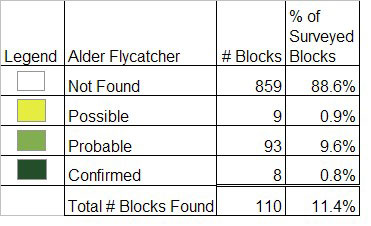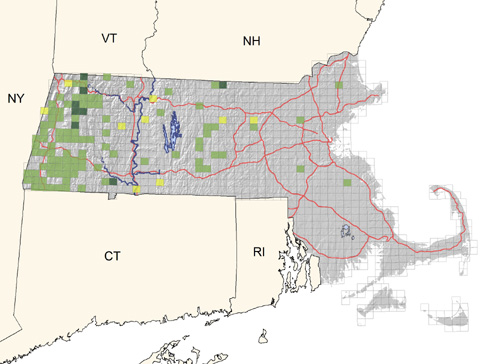Breeding Bird Atlases (BBA)
Find a Bird - BBA1
Breeding Bird Atlas 1 Species Accounts
Alder Flycatcher
Empidonax alnorum
Egg Dates
June 19 to July 22
Number of Broods
one; may re-lay if first attempt fails.

The Alder Flycatcher is a fairly common and widespread summer resident in Berkshire County. It nests eastward into the northern and central Massachusetts uplands, where it may be locally common. It breeds much less frequently in the Connecticut River valley lowlands and probably very rarely east of Worcester County, where it appears to be largely replaced by the Willow Flycatcher. Historically, this species nested widely over eastern Massachusetts, but, faced with increasing competition from the more aggressive Willow Flycatcher, it has retreated into the more upland and western reaches of the state.
The historic trends of Alder and Willow flycatchers in Massachusetts are somewhat obscure, owing to the fact that until 1973 the two were treated as song-types of the Traill’s Flycatcher. The Alder (fee-bee-o or burr-ree-ah song type) was historically the principal form in Massachusetts, with the Willow (fitz-bew or witch-brew song type) generally more southern and western in its distribution.
However, Stein (1958), in a classic study, brought some order to a chaotic situation, demonstrating that the Willow Flycatcher appeared to be invading traditional Alder Flycatcher range and ultimately predominating by active displacement in many areas in central New York State, especially at lower elevations. By the early 1960s, Willow Flycatchers were being widely recognized in Massachusetts, and they rapidly expanded their range eastward to the coast, displacing the Alder Flycatcher at many sites along the way and occupying new areas as well.
Although both species have similar advertising songs, a trained ear readily differentiates the songs. There is no overlap of pattern, and neither species will respond to song tapes of the other. Alder and Willow flycatchers typify congeners that are similarly colored and patterned and that rely upon sound instead of visual stimuli for species differentiation. The Alder Flycatcher’s buzzy song, fee-bee-o, with the second syllable highest and accented, is the only way this species can be positively identified in the field. It has several other vocalizations, including a rasping queeoo, delivered in the same manner as the song, and a pip call note.
Alder Flycatchers arrive in the third week of May. In addition to its distinctive song, its habitat preference and nest site and structure have been shown to be specifically distinct from that of the Willow Flycatcher. Pure stands of alder are sometimes occupied, as are brushy areas of alder intermixed variably with dogwood and Arrowwood. The thickets used are almost always near water—along the edges of streams, bogs, swamps, and Beaver flowages—and are sometimes at the edges of mature forest.
Nests are coarse and loosely built and are situated low, usually only 1 to 4 feet above the ground. Old records of nests from the former breeding grounds in eastern Massachusetts indicate that many were placed in wild rose plants and 1 in Meadowsweet, all at the typical heights (ACB). A pair in Charlton was observed building a nest at 3 feet in an alder on June 14 (Meservey). Clutches consist of three to four eggs, which are laid on consecutive days, with incubation commencing after the laying of the last one. One nest in the Berkshires contained three eggs on July 22 (Kroodsma). The incubation period is approximately 14 days. One brood is raised each year, but the birds are capable of renesting, an obvious benefit in years when the low nests are swamped by heavy June rains. The young are altricial and fledge at approximately 14 days. A nest in the Berkshires contained three young on July 22, and a second contained three nestlings on July 26 (Kroodsma). Fledglings in the Berkshires were reported on July 19 (three young) and July 24 (2 groups of young) (Kroodsma).
Little is known about post-nesting events. Although birds may be quite vocal into early July, they become silent and are almost impossible to locate after the end of the month. As a result, departure dates are poorly known but, based on banding data, are probably from late August to mid-September. The literature is confusing with regard to the winter range. According to the A.O.U. Check-list of North American Birds (American Ornithologists’ Union 1983), the species presumably winters in South America and has been definitively recorded from Peru. Individuals of the “traillii complex” have been reported from Colombia and northwestern Venezuela south, east of the Andes, to eastern Peru, Bolivia, and northern Argentina.
Map Legend and Data Summary
Atlas 1 data collected from 1975-1979


Note: uncommon in moist thickets in higher elevations of western portion of state; slowly spreading eastward
Bradford G. Blodget



